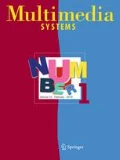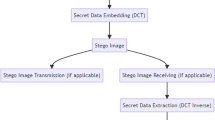Abstract
Steganalysis is a technique for detecting existence of secret data hidden in digital media. Researchers are often concentrated in minimizing the misclassification rate. Many steganalysis methods try to choose high-dimension features to reveal subtle changes due to data embedding. By exploring properties of the filter bases, we steer the filters to capture tiny embedding traces in different scales and directions. There are redundant filters due to the horizontal and vertical symmetric properties. To select proper filters, the constructed framework selects a filter subset used in feature extraction and can improve the classification performance. The proposed algorithm is compared with several high-dimension features including Gabor filter residual (GFR) and maximum diversity cascade filter residual (MD-CFR) features. The following steganographic algorithms are used in the comparison experiment to test the steganalytic performance: uniform embedding revisited distortion (UERD) and JPEG universal wavelet relative distortion (J-UNIWARD). Experimental results show that, compared with the MD-CFR method, the proposed method can increase the detection rate by up to 0.7% with low feature dimension. It is shown that the proposed method is suitable for detecting data embedding in JPEG images.



Similar content being viewed by others
References
Boroumand, M., Chen, M., Fridrich, J.: Deep residual network for steganalysis of digital images. IEEE Trans. Inf. Forensics Secur. 14(5), 1181–1193 (2019)
Chen, K., Zhou, H., Zhou, W., Zhang, W., Yu, N.: Defining cost functions for adaptive jpeg steganography at the microscale. IEEE Trans. Inf. Forensics Secur. 14(4), 1052–1066 (2019)
Denemark, T., Boroumand, M., Fridrich, J.: Steganalysis features for content-adaptive jpeg steganography. IEEE Trans. Inf. Forensics Sec. 11(6), 814–825 (2016)
Fan, L., Sun, W., Feng, G.: Image steganalysis via random subspace fisher linear discriminant vector functional link network and feature mapping. Mob. Netw. Appl. 24(4), 1269–1278 (2019)
Feng, G., Zhang, X., Ren, Y., Qian, Z., Li, S.: Diversity-based cascade filters for jpeg steganalysis. IEEE Trans. Circuits Syst. Video Technol. 30(2), 376–386 (2020)
Fridrich, J., Goljan, M.: Practical steganalysis of digital images: state of the art. In: Proceeding of the SPIE, security and watermarking of multimedia contents IV, pp. 1–13 (2002)
Fridrich, J., Kodovsky, J.: Steganalysis in high dimensions: fusing classifiers built on random subspaces. In: Proceedings of SPIE electronic imaging, media, watermarking, security and forensics XIII, pp. 1–13 (2011)
Guo, L., Ni, J., Shi, Y.Q.: Uniform embedding for efficient jpeg steganography. IEEE Trans. Inf. Forensics Secur. 9(5), 814–825 (2014)
Guo, L., Ni, J., Su, W., Tang, C., Shi, Y.Q.: Using statistical image model for jpeg steganography: uniform embedding revisited. IEEE Trans. Inf. Forensics Secur. 10(12), 2669–2680 (2015)
Holub, V., Fridrich, J., Denemark, T.: Universal distortion function for steganography in an arbitrary domain. EURASIP J. Inf. Secur. 2014(1), 1 (2014)
Holub, V., Fridrich, J.: Low complexity features for jpeg steganalysis using undecimated dct. IEEE Trans. Inf. Forensics Secur. 10(2), 219–228 (2015)
Jin, Z., Feng, G., Ren, Y., Zhang, X.: Feature extraction optimization of jpeg steganalysis based on residual images. Signal Process. 170(5), 107455 (2020)
Kodovsky, J., Holub, V., Fridrich, J.: Ensemble classifiers for steganalysis of digital media. IEEE Trans. Inf. Forensics Secur. 7(2), 432–444 (2012)
Lie, W., Lin, G.: A feature-based classification technique for blind image steganalysis. IEEE Trans. Multimed. 7(5), 1007–1020 (2005)
Provos, N.: Defending against statistical steganalysis. Usenix Secur. Symp. 10, 323–336 (2001)
Sallee, P.: Model-based steganography. In: International workshop on digital watermarking. Springer, Berlin. pp. 154–167 (2003)
Shi, Y., Chen, C., Chen, W.: A markov process based approach to effective attacking jpeg steganography. In: Proceedings of information hiding on 8th international workshop, pp. 249–264 (2007)
Song, X., Liu, F., Yang, C., Luo, X., Yi, Z.: Steganalysis of adaptive jpeg steganography using 2d gabor filters. In: Proceedings of the 3rd ACM workshop on information hiding and multimedia security, pp. 15–23 (2015)
Xu, G., Wu, H., Shi, Y.: Structural design of convolutional neural networks for steganalysis. IEEE Signal Process. Lett. 23(5), 708–712 (2016)
Xu, G.: Deep convolutional neural network to detect j-uniward. In: Proceedings of the 5th ACM workshop on information hiding and multimedia security, pp. 67–73 (2017)
Zhong, K., Feng, G., Shen, L., Luo, J.: Deep learning for steganalysis based on filter diversity selection. Sci. China Inf. Sci. 61(12), 129105 (2018)
Zhou, L., Feng, G., Shen, L., Zhang, X.: On security enhancement of steganography via generative adversarial image. IEEE Signal Process. Lett. 27(1), 166–170 (2020)
Acknowledgements
This study was funded by the National Natural Science Foundation of China under Grant No. 62067006, the Gansu Provincial Science and Technology Project under Grant No. 18JR3RA104, the Industrial Support Program for Colleges and Universities in Gansu Province under Grant No. 2020C-19, the Science and technology project of State Administration of market supervision and Administration under Grant No. 2019MK150, the Lanzhou Science and Technology Project under Grant No. 2019-4-49.
Author information
Authors and Affiliations
Corresponding author
Additional information
Publisher's Note
Springer Nature remains neutral with regard to jurisdictional claims in published maps and institutional affiliations.
Rights and permissions
About this article
Cite this article
Luo, W., Dang, J., Wang, W. et al. Low-complexity JPEG steganalysis via filters optimation from symmetric property. Multimedia Systems 27, 371–377 (2021). https://doi.org/10.1007/s00530-021-00780-y
Received:
Accepted:
Published:
Issue Date:
DOI: https://doi.org/10.1007/s00530-021-00780-y




